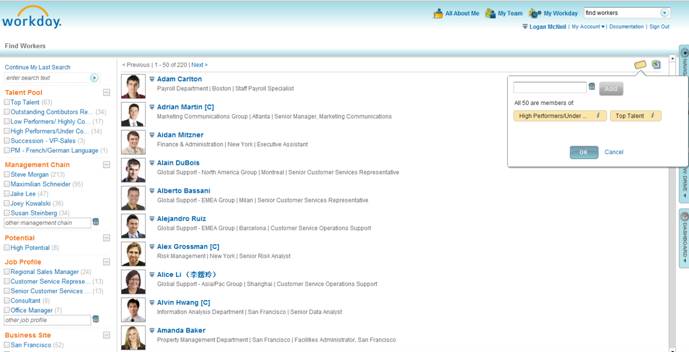Workday 12 - Working for you
I don’t need to repeat the Workday story again here, but the general narrative is this: by building a modern, next generation ERP/HCM solution from scratch, taking advantage of SaaS deployment to rapidly iterate and deploy new features and capabilities, and lastly (but perhaps most importantly), by giving mid-size and large global customers a real choice outside of the ERP trinity of SAP, Oracle E-Business Suite, or Oracle PeopleSoft), Workday has become the most interesting company in enterprise technology in the last 5 years.
Recently Workday released the latest version of the suite, Workday 12. The team at Workday was nice enough to give me a briefing and demonstration of a few of the new features in this latest release. And there are lots of new features in the HCM and Talent Management areas. But during the demonstration one new feature in particular, called ‘Faceted Search’, stood out for me, and I think provides some insight on what has been one of the traditional failures of big, enterprisey technology solutions, and perhaps gives us a glimpse at what a better and more flexible enterprise solution landscape might look like.
With Faceted Search, Workday provides the ability for line managers, project managers, HR leaders, talent planners - pretty much anyone with the responsibility for finding, assessing, and deploying the ‘right’ people to the ‘right’ roles, projects, and assignments; to flexibly and with a high degree of personalization locate, tag, and take relevant actions on a group of resources. These groups can be created on the fly, in real-time, and shared as needed and desired across the organization.
One use case might be for an HR Talent Planner to run an advanced search for all Director level employees that are high performers, but have compensation below the average for their peer group.
Screen 1 - Search results with corresponding user-defined tag

The talent planner can immediately create a custom ‘tag’ or grouping of the selected employees, e.g., ‘Retention Risk - Directors’, and from there with one-click a number of actions can be launched for the new talent pool’ - start a development plan, initiate a one-time bonus, or add to a project resource list, etc.
Screen 2 - Launching a targeted action on behalf of newly defined Talent Pool

This is cool and noteworthy not just because of the slick user interface and the powerful functionality, but because it allows the talent planner to make the system adapt to the way he/she needs it to work, and not the other way around. Identifying the target population, creating the search, modifying the search results, augmenting the results with descriptive meta-data (the tag), and finally taking specific and targeted actions based on this brand new construct (the Retention Risk - Directors group), supports the talent professional in their needs and the needs of most organizations to better understand their talent, to deploy that talent faster and more efficiently, and to adapt to changing conditions and requirements.
Look, I am not so naive to know that for many organizations the exceedingly hard work of performance management, compensation planning, and talent assessment would all (or mostly) need to be in place before they could fully leverage this kind of powerful capability to turn the information into action. But, I do think that by allowing more user control of the experience, the definitional data, and with the ability to rapidly and broadly share and socialize these user-created constructs, that organizations will have more opportunity to take advantage of these kinds of advanced and powerful capabilities.
There are numerous reasons why (for most users) traditional enterprise systems suck. Having to change the way you want to work to adapt to an inflexible, rigid process and structure is certainly chief among said reasons. Rigiditiy and repeatability is great when the process is paying bills or calculating quarterly taxes; it isn’t so great when the question to be answered is how to find, deploy, and reward the ‘right’ people to the ‘right’ place at the ‘right’ time. The answer to that question changes every day, and tools like Workday’s Faceted Search are a step towards providing solutions that can help talent professionals come up with the right answers.
Thanks very much to Leighanne Levensaler and the team at Workday for the briefing last week.

 Steve
Steve
